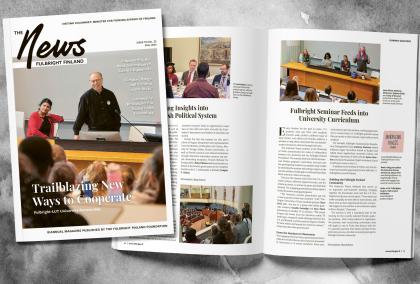Books and bulky items, such as winter clothing, may exceed your airline luggage capacity, but you may also want to check the university library online before bringing a large number of books with you. There are large libraries in Finland with extensive English resource materials.
Almost anything that can be bought in the U.S. can also be bought in Finland, but quite often at a considerably higher price. Some American specialties cannot be found in Finland.
We recommend bringing along the following:
- a laptop (with a currency converter)
- some winter clothing (esp. shoes and/or boots)
- important documents such as marriage certificates and children’s birth certificates, incl. a notary seal and an apostille (if you are bringing your family)
- a recommendation letter from your U.S. bank - sometimes asked for when opening an account with a Finnish bank (customer in good standing)
- some "business" clothes for official meetings (a suit)
- books, academic material needed for lecturing, etc. if not available in libraries.
- some small gifts for social occasions
- prescription medicine and the prescription itself (N.B. you are allowed to bring a maximum of 3 months supply into Finland), please see further information on regulations related to bringing medicine to Finland on the Customs website and Kanta services
- vitamins (according to Fulbright alumni, vitamins are cheaper and stronger in the U.S.)
- same for contact lenses (according to Fulbright alumni, they are more expensive in Finland)
- American food specialties you cannot live without!
In the U.S. you get more different kinds of medicine over the counter compared to Finland. In Finland, a variety of medicine requires a doctor's prescription, especially those for cold or flu, which you would get over the counter in the U.S.
-U.S. Fulbright Student Grantee 2018-2019
Bring (or buy) a warm, rainproof jacket that has a hood on it. Wool coats are great for the cold, but in the rainy/snowy winter months, they aren't very practical.
For students applying for degree programs, it is a good idea to bring a copy of their transcripts and coursework for review with advisers when determining how many supplemental credits are required. In my case, the basis for my initial rejection was due to a misunderstanding that I would require more than 60 supplemental credits. After the meeting with my adviser, it was reduced to a book exam and 8 credits of coursework.
-U.S. Fulbright Student Grantee 2015-2016
We do not recommend bringing to Finland:
- Personal checks. Checks are not used in Finland, and cashing them is expensive. eBanking is largely used in Finland.
- Too many clothes. Many former grantees have discovered that second-hand shopping can be a valid and inexpensive option, especially for winter wear.
- A car. Some grantees have brought cars or purchased a new car for subsequent import to the United States. This may enable you to choose from a greater variety of housing since you will be less dependent on public transportation. However, you should be aware of the tremendous expenses if you are thinking of using your own car, and most of Finland has well-functioning public transport. And if you need a car, you can always rent one.
- Electronic equipment, unless it can be switched using the European 220v voltage. Finland uses the standard European 220-volt/50-Hz electrical current rather than the U.S. 110/60. Your electronic equipment must be compatible with 220/50 in order to operate properly.
- Pets. It can be done, but since you might be traveling a lot while staying in Finland (and in Europe), arranging for someone to take care of your pets might prove a challenge and a distraction.
Shipping Goods to Finland
I would not ship. Super expensive. Pay for an extra bag!- U.S. Grantee 2014-2015
Shipping Options
Parcel post is one option to have goods shipped to Finland. Unlike some parts of the U.S., parcels are not delivered directly to the mailing address, but rather to a nearby postal outlet. However, do not mail packages in your name to your host university unless you have specifically arranged for someone to pick them up. Again, you should give your shipment at least two months to make its way to Finland.
EU regulations for parcels arriving outside of the EU changed on July 1, 2021. All parcels arriving from outside the EU must be declared - Finnish Customs
Please see our website for instructions on receiving packages outside of the EU.
I used the U.S. Post Office to ship things to my home address. Others had problems shipping to their university/office addresses. When I sent things via U.S. Post Office, they arrived with no problem at my house. I got a notice to pick them up at the local post office in Finland. When my father shipped things to me, they got stuck in Customs. I was able to call Customs and convince them that they were my goods being shipped to myself, so be careful how you fill out the Customs form. Best to ship from your name to your name so Customs in Finland will not detain the packages. - U.S. Grantee 2014-2015
It's doable, but it was very expensive. Also remember that if for instance, you don't live in Helsinki, and somewhere further north, the distribution system gets relatively scant. I often had to wait a whole day for a package to show up because some guy in a van had to drive from Helsinki. If you're a student I really wouldn't recommend it, there's very little you actually need shipped, just be adaptable and find a local alternative, you'll be better off. - U.S. Grantee 2014-2015
Air courier services such as Federal Express, United Parcel Service International, and DHL, may be used for small packages. They handle customs clearance and possible duty payment and deliver directly to your door (the bill comes later). While convenient for urgent shipments, they are expensive and seldom practical for personal effects.
Air, ocean, and rail freight (through private logistics companies) are options that neither former grantees nor the Fulbright Finland Foundation staff recommends. All freight shipments will incur customs clearance and handling fees, and will also incur substantial daily storage charges if they are held longer than 48 hours in the local terminal.
Mail Sacks
If you are bringing large quantities of books, one cheap option from the U.S. has been the Direct Mail Sack rate. For this rate, several small boxes of books or printed matter, each wrapped and labeled, can be combined in a large canvas mail sack (“M-sack”) that is then shipped to Finland. Unlike parcel post, Direct Mail Sacks are only for printed material and cannot be insured. Consult your local U.S. post office early about their M-sack availability. Keep all postal and insurance receipts in the event of claims, or for possible U.S. tax deductions.
It is advisable to carefully consider different mailing options. For example, according to a former grantee, the cost advantage of M-sacks may be offset by the potential length of time it takes and the inability to track the packages. Also, Finnish customs may require a detailed declaration of the contents of Mail Sacks, and in some cases, you should be prepared to pay extra customs tax on the material in Mail Sacks. And remember that you will eventually have to mail everything back home as well unless you want to leave all your books and materials behind. The M-bag service is not available in Finland, which does increase your return costs.


